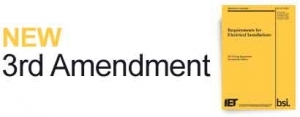
|
|
| home | contact | team t&d | group websites | markets | exports | blog |
 |
|
BS7671 Non-Compliance - Safe Selection of Devices For Installation in Assemblies
By Chris Dodds on 2nd July, 2015

Non compliant "BS7671" installations often feature a potentially lethal cocktail of manufacturers devices that may not have been tested as a completed unit - whilst this "mix and match" attitude might be acceptable practice in Europe, it definitely does not comply with British Standards.
In order to provide certainty and clarity, BEAMA thankfully have provided the following Technical Bulletin. Special thanks also due to Darren Garbett (Business Development Manager at Electrium part of Siemens Low Voltage Products). Electrium are residential circuit protection specialists and market-leaders.
Special thanks also due to Darren Garbett (Business Development Manager at Electrium part of Siemens Low Voltage Products). Electrium are residential circuit protection specialists and market-leaders.
BEAMA is the leading trade association which represents manufacturers of electrical infrastructure products and systems from transmission through distribution to the environmental systems and services in the built environment.
and systems from transmission through distribution to the environmental systems and services in the built environment.
BEAMA work with their members to ensure their interests are well represented in the relevant political, regulatory and standardisation issues at UK, EU & international levels.
Safe Selection of Devices For Installation in Assemblies - June 2013
BEAMA takes safety seriously and warns against the incorrect selection of devices (e.g. RCBOs, MCBs, MCCBs) for installation into assemblies1 (e.g. consumer units, distribution boards, panelboards). There are two scenarios to be aware of:
a) The practice of installing devices of one manufacturer into assemblies of another manufacturer.
b) The practice of installing new devices into an old assembly, even if both are of the same manufacturer.
There is evidence that this practice of mixing products by installers, often without fully understanding the safety implications, is commonplace. Although devices can appear similar; the dimensions, technical performance and terminals are not necessarily compatible and mixing products in this way is likely to result in an unsafe installation.
In the case of scenario a), assemblies such as consumer units, distribution boards and panelboards conforming to BS EN 61439, formerly BS EN 60439 or BS 5486, are tested with specific devices which are usually from the same manufacturer as the enclosure.
In the case of scenario b), it should not be assumed that old and new devices and assemblies from the same manufacturer are compatible, because products are subject to continuous development. Over time, new ranges may be released, which may not necessarily be backwards compatible.
Therefore, in both scenarios, it is essential that the assembly manufacturer’s guidance is sought concerning suitability of any substitution or addition.
In all cases installing devices other than those declared by the assembly manufacturer invalidates any testing/certification and warranty.
BS 7671 regulation 510.32 places specific responsibility on the installer, requiring that assembly manufacturer’s instructions are taken into account.
In Conclusion
• It is the responsibility of the installer who intends to mix devices/components in an assembly, to undertake appropriate testing and ensure conformity with the relevant standard.
• The installer has responsibility to act "with due care". If this is not done then there is a probability that, in the event of death, injury, fire or other damage, the installer would be accountable under Health and Safety legislation.
Distributor & Wholesaler Responsibilities
A distributor or wholesaler also has a responsibility under the General Product Safety Regulations to act "with due care". Distributors and wholesalers should be able to substantiate any advice related to interchangeability of devices in assemblies. If the installer acts on a distributor's advice and information and in doing so produces a non-compliant assembly then both the distributor and installer may be liable for any consequences.
1 An assembly is an enclosure and all its associated mechanical and electrical components such as the enclosure, busbars, terminals and electrical devices.
2 BS 7671:2008 including amendment 1 (previously 510.2).
Finally, manufacturers insist in order to safeguard householder safety only a competent electrician does the install and testing of the domestic consumer unit. As we covered in a previous article, the bitterness of poor quality remains long after the sweetness of a low price is forgotten.
A single point of reference for consumers seeking an electrical contractor is now available www.electricalcompetentperson.co.uk and in Scotland in the form of the Scottish www.certificationresgister.co.uk
Further BS7671 Reading
Consumer Units For Use In Domestic (Household) Premises - The Impact Of Amendment No.3 To BS7671
Fire Resistant Cable Ties Support BS7671 Compliant Fire Alarm & Detection Installations
Every working day we are in rented properties the safety of tenants should be a concern to any landlord. What a mess pic.twitter.com/l6QjnwWLRC
— Reliable Electrician (@ReliableElec) June 23, 2015
What about cable entries on Amendment 3 consumer - Wylex Installation video for handy hints http://t.co/Z8S4hrG1hN pic.twitter.com/WjJSbRUbtu
— Electrium Marketing (@ElectriumNews) June 26, 2015
New regulations come into effect next week follow this link for fully compliant consumer units http://t.co/vcGIYfUMDm pic.twitter.com/iEp2oPPUT9
— Electrium Marketing (@ElectriumNews) June 26, 2015
 | Wylex - Domestic, Commercial & Industrial Circuit Protection |
Category: LV Cable Jointing & Terminating
Sort by Category:
- #ThrowBackThursday
- 3M Scotch Tapes
- ABB Power Products
- Business
- Cable Accessories
- Cable Cleats & Cable Ties
- Cable Containment LV HV
- Cable Crimping & Cutting Tools
- Cable Jointer Training Courses
- Cable Jointing - PhotoBlog
- Cable Labelling & Marking
- Cable Laying & Cable Pulling
- Cable Transits & Duct Sealing
- Company Updates
- Earthing & Lightning Protection
- Electrical Equipment HV
- Electrical Equipment LV
- Electrical Safety & Arc Flash
- Exports
- Flexible Conduit Cable Management
- Hazardous Area Electricals & Lighting
- HV Cable Jointing & Terminating
- LV Cable Jointing & Terminating
- Nexans Euromold Cable Accessories
- Plugs & Sockets
- Power Distribution & Feeder Pillars
- Prysmian FP Cables
- PV Solar Farms
- Rail
- T&D History Blog
- Terms & Conditions of Sale & Purchase
Tweets by @ThorneanDerrick




























